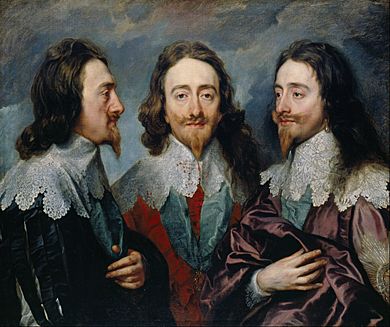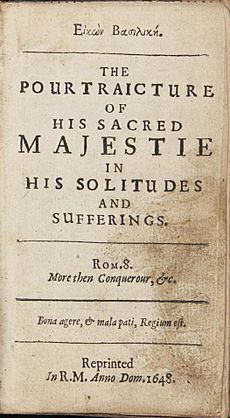Eikon Basilike facts for kids
The Eikon Basilike (which means "Royal Portrait" in Greek) is a famous book. It is thought to be the spiritual autobiography of King Charles I of England. It was published on February 9, 1649. This was just ten days after the King was beheaded by Parliament. This happened after the English Civil War in 1649.
Contents
What's Inside and Who Wrote It?

The book is written like a diary. It has a simple, moving style. It includes prayers that ask for forgiveness for those who executed Charles. It also explains why royalty should rule. The book defends the King's plans that led to the English Civil War.
Who Really Wrote the Book?
It is not fully clear if King Charles I wrote the book himself. After the Restoration (when the monarchy was brought back), John Gauden, a bishop, said he wrote it. Experts still debate if Gauden's claim is true. If he did write it, he likely used Charles's own notes. Jeremy Taylor is also thought to have helped edit the book. He might have even given it its title. An earlier version was called Suspiria Regalia, meaning "Royal Sighs".
William Levett, a long-time helper to the King, swore he saw Charles writing the book. This happened while Levett was with the King in prison on the Isle of Wight. Levett was also there when the King was executed. He later helped move the King's body to Windsor Castle for burial.
How the Book Portrayed King Charles
Whoever wrote the Eikon Basilike was a skilled writer. The book's style was serious and simple. It was like the language used in the Book of Common Prayer. The book made Charles look like a strong monarch (ruler). He admitted his weaknesses but stood firm in his religious beliefs. He also said his political reasons were pure. The book showed him trusting God even in hard times.
It said Charles's main weakness was giving in to Parliament's demands. This was when he allowed the Earl of Strafford to be executed. The book suggested that Charles lost his throne and life because of this "sin". The way the book showed Charles as a martyr made people compare him to Jesus.
The Book's Impact and Popularity
This dramatic story made the book a powerful piece of Royalist propaganda. It was very popular, even though it was officially disliked during the Protectorate (when England was a republic). In 1649 alone, it was printed 36 times. In 1657, it even became a musical work. Thomas Stanley wrote the verses, and John Wilson composed the music.
Because the book made the King look so good, Parliament asked John Milton to write a response. Milton published his book, Eikonoklastes ("The Icon-Breaker"), in 1649. Milton's book tried to show that Charles and his idea of absolute monarchy were like idols. He argued that such reverence should only be given to God. Therefore, he said, Charles was rightly overthrown. However, Milton's argument did not stop the public from loving the Eikon Basilike.
The Book's Front Cover Image
The front cover image, called a frontispiece, was made by William Marshall. There are seven slightly different versions of this image. For example, the angle of the King's head might change.
The frontispiece of the Eikon Basilike is full of symbols. It shows the King as a Christian martyr. Here are some of the Latin phrases on the image and what they mean:
- IMMOTA, TRIVMPHANS — "Unmoved, Triumphant" (around the rock).
- Clarior é tenebris — "Brighter through the darkness" (a beam from the clouds).
- CRESCIT SUB PONDERE VIRTVS — "Virtue grows beneath weights" (around the tree).
- Beatam & Æternam — "Blessed and Eternal" (around the crown in heaven, marked GLORIA meaning "Glory"). This is compared to:
- Splendidam & Gravem — "Splendid and Heavy" (around the Crown of England, which is on the ground). This crown has the word Vanitas meaning "vanity".
- Asperam & Levem — "Bitter and Light" (the crown of thorns held by Charles). This crown has the word Gratia meaning "grace".
- Coeli Specto — "I look to Heaven".
- IN VERBO TVO SPES MEA — "In Thy Word is My Hope".
- Christi Tracto — "I entreat Christ" or "By the word of Christ".
- Mundi Calco — "I tread on the world".
In the first edition of the book, the frontispiece had Latin and English poems explaining it. The English verses say:
Though clogg'd with weights of miseries
Palm-like Depress'd, I higher rise.
And as th'unmoved Rock out-brave's
The boist'rous Windes and rageing waves
So triumph I. And shine more bright
In sad Affliction's darksom night.
That Splendid, but yet toilsom Crown
Regardlessly I trample down.
With joie I take this Crown of thorn,
Though sharp, yet easy to be born.
That heavn'nly Crown, already mine,
I view with eies of Faith divine.
I slight vain things: and do embrace
Glorie, the just reward of Grace.
King Charles Honored by the Church of England
The Eikon Basilike and its portrayal of Charles's execution as a martyrdom were very successful. Because of this, after the Restoration, a special day was added to the Book of Common Prayer. This day, January 30, was for remembering the King. It was a day for fasting and repentance.
On May 19, 1660, the Church of England officially made King Charles a saint. This happened because Charles II asked for it. Charles I is the only saint formally recognized by the Church of England.
This special day was later removed from the prayer book by Queen Victoria in 1859. However, some Anglican churches and chapels are still named after "King Charles the Martyr". The Society of King Charles the Martyr was started in 1894. Its goal is to bring the King's name back to the Church calendar. It also encourages people to honor the "Royal Martyr".
A Quote from the Book
I would rather choose to wear a crown of thorns with my Saviour, than to exchange that of gold, which is due to me, for one of lead, whose embased flexibleness shall be forced to bend and comply to the various and oft contrary dictates of any factions, when instead of reason and public concernments they obtrude nothing but what makes for the interest of parties, and flows from the partialities of private wills and passions. I know no resolutions more worthy a Christian king, than to prefer his conscience before his kingdoms.
See also
- Society of King Charles the Martyr
- English Civil War
- Eikonoklastes




